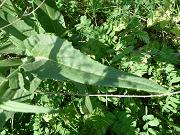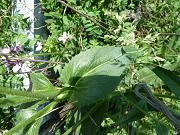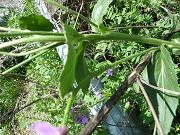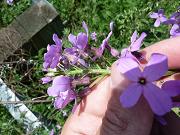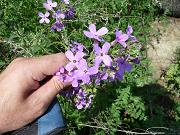Transformational Gardening
May 2011 Foraging Experiences
(Back to:
April 2011 Foraging Experiences)
(Forward to:
June 2011 Foraging Experiences)
May 1, 2011
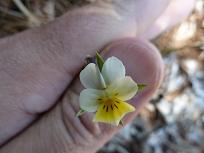
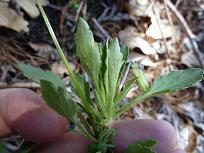 My first violet posted to this site! Notice how the flowers are bilaterally symetrical.
That means that if you drew a line down the center, the left and right sides would
be the same. This is similar to the human body (the left and right sides are the same).
My first violet posted to this site! Notice how the flowers are bilaterally symetrical.
That means that if you drew a line down the center, the left and right sides would
be the same. This is similar to the human body (the left and right sides are the same).
There are a number of white flower violets in New Hampshire, but this one was easy to
identify because it is the only one with white flowers and a distinct yellow lower
lip. In some cases, the upper petals are tipped with purple. A single flower grows
on a stem originating from the leaf axil. The flower towers well above the leaves.
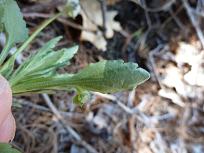
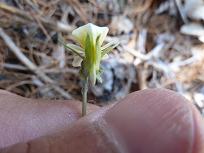 The basal leaves are round to spatulate. The middle and upper leaves tend to be
elliptical with coarsely-rounded teeth. The leaf veins on the underside of the leaf
are hairy.
The basal leaves are round to spatulate. The middle and upper leaves tend to be
elliptical with coarsely-rounded teeth. The leaf veins on the underside of the leaf
are hairy.
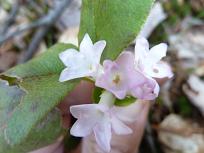
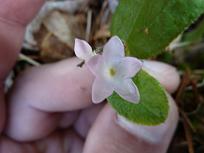
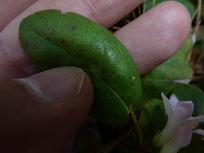
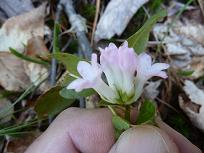
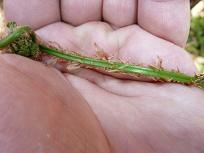
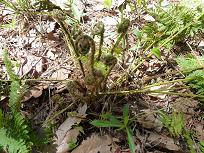 I had thought this was Ostrich Fern (Matteuccia struthiopteris) as
almost every foraging guide says to look for a deep groove, brown papery
sheath falling off the fiddlehead and no hairs. Thank you to Frank and to Arthur
for pointing out that this is Intermediate Woodfern. Arthur told me:
I had thought this was Ostrich Fern (Matteuccia struthiopteris) as
almost every foraging guide says to look for a deep groove, brown papery
sheath falling off the fiddlehead and no hairs. Thank you to Frank and to Arthur
for pointing out that this is Intermediate Woodfern. Arthur told me:
“Your plant is a species of Dryopteris (wood fern). Specifically it is Dryopteris intermedia
(evergreen wood fern). Notice that the papery scales on the petiole and leaf blade are very
abundant (not so in Matteuccia). Notice also they are attached to the petiole and will
persist on the plant (not so in Matteuccia, they fall off as the leaf expands). Also notice
all of the remnant leaves from last year lying on the ground pointing away from the fiddleheads
in the center. Those leaves are very different from Matteuccia (too divided and not tapering
to the base).”
May 6, 2011
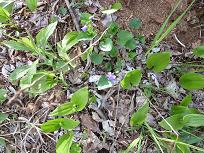
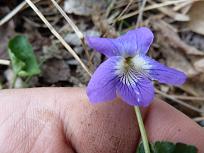 For me, differentiating between species of violet can be very easy in some cases and
very difficult in other cases. If I had to rely on descriptions in a typical field
guide, I would have no chance, especially in this case. What I think is far better
are step-by-step “Identification Keys”. The one I found the most useful
for Violets in my area is the
New Brunswick Botany Club Violet Indentification Key (also found
in PDF format here).
A couple of other useful keys were the
Northern Ontario Plant Database Violet Key (scroll down to see Key) and the
American Violet Society Dichotomous Key (Eastern U.S.).
For me, differentiating between species of violet can be very easy in some cases and
very difficult in other cases. If I had to rely on descriptions in a typical field
guide, I would have no chance, especially in this case. What I think is far better
are step-by-step “Identification Keys”. The one I found the most useful
for Violets in my area is the
New Brunswick Botany Club Violet Indentification Key (also found
in PDF format here).
A couple of other useful keys were the
Northern Ontario Plant Database Violet Key (scroll down to see Key) and the
American Violet Society Dichotomous Key (Eastern U.S.).
This case was particularly difficult because many botanists and guides
no longer recognize Northern Woodland Violet (Viola septentrionalis) as a
separate species, but now categorize it as part of Viola sororia. Unfortunately,
the written descriptions of Viola septentrionalis sometimes conflict with
that of Viola sororia.
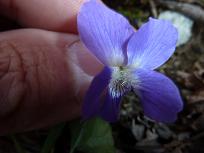
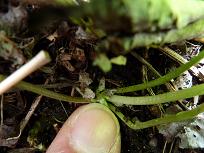 The second row of pictures show that the plant has no above-ground stem -- leaf stems
and flower stems come right from the level of the ground. This eliminated Viola adunca
and Viola labradorica as possibilities. The second picture in the row shows there
are hairs on the lateral (side) petals of the flower. This eliminated Viola selkirkii
as a possibility. In addition, you can see that the little hairs are not dialated
(swollen) at the apex (tip). This eliminated Viola cucullata and Viola
x bissellii as possibilities.
The second row of pictures show that the plant has no above-ground stem -- leaf stems
and flower stems come right from the level of the ground. This eliminated Viola adunca
and Viola labradorica as possibilities. The second picture in the row shows there
are hairs on the lateral (side) petals of the flower. This eliminated Viola selkirkii
as a possibility. In addition, you can see that the little hairs are not dialated
(swollen) at the apex (tip). This eliminated Viola cucullata and Viola
x bissellii as possibilities.
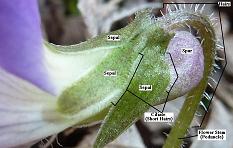
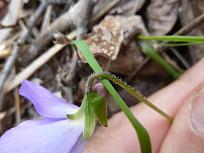 The third row of pictures show that the sepals (the petals that lie under the flower
and are usually green) are ciliate (have short hairs). There are other ways to
differentiate between violets, but I think this is the most efficient process.
This eliminated Viola novae-angliae and Viola nephrophylla as
possibilities.
The third row of pictures show that the sepals (the petals that lie under the flower
and are usually green) are ciliate (have short hairs). There are other ways to
differentiate between violets, but I think this is the most efficient process.
This eliminated Viola novae-angliae and Viola nephrophylla as
possibilities.
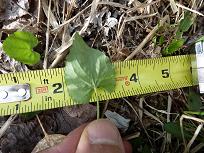
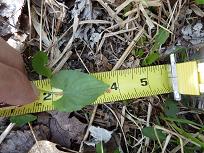 The fourth row of pictures shows that the typical leaf is as long or longer than it
is wide. Therefore, I was able to eliminate Viola sagittata var. ovata as a
possibility. According to this Key, the only option left was Viola sororia.
The fourth row of pictures shows that the typical leaf is as long or longer than it
is wide. Therefore, I was able to eliminate Viola sagittata var. ovata as a
possibility. According to this Key, the only option left was Viola sororia.
However, I used the USDA Plant Database search to perform an
Advanced Search to see
what Violets were found in New Hampshire and then proceeded to write down which
were purple or blue violets and which of those were not in the New Brunswick Key
I used. The ones not in the Key were: Viola affinis, Viola rostrata
and Viola septentrionalis. Viola affinis has a hairless or nearly
hairless flower stem. As you can see from pictures below, this flower had a very
hairy flower stem. Viola rostrata has a huge spur (spike) rising up high
from the back of the flower (as can be seen from pictures online). This flower
had no huge spike.
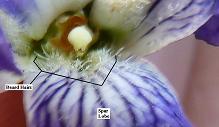
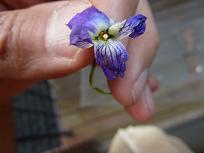 This left either the original Key selection, Viola sororia or
Viola septentrionalis. Several descriptions I ready for Viola
sororia said that the spur flower petal (bottom middle petal) had no
hairs. But as can be seen from the pictures on the fifth row, the bottom
middle flower petal (spur petal) has hairs. Even though Viola septentrionalis
is often categorized under Viola sororia, it has a spur petal with hairs.
This left either the original Key selection, Viola sororia or
Viola septentrionalis. Several descriptions I ready for Viola
sororia said that the spur flower petal (bottom middle petal) had no
hairs. But as can be seen from the pictures on the fifth row, the bottom
middle flower petal (spur petal) has hairs. Even though Viola septentrionalis
is often categorized under Viola sororia, it has a spur petal with hairs.
Viola septentrionalis also fits other descriptions and images that I have
seen including a very hairy stem, some hairs on the leaves, hairs on the leaf
blades and growing in moist open woodlands. Since Viola septentrionalis
is categorized as Viola sororia by most botanists, I decided to do so
as well.
I ate several leaves. They were a touch bitter and it is probably best to
not eat a violet salad without any other ingredients, but they were not bad.
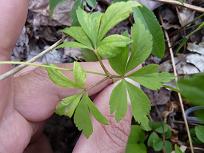
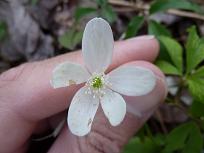
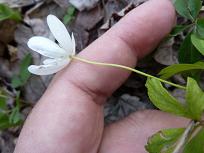

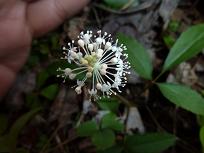
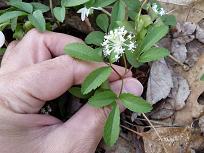
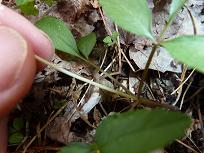
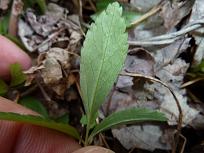
May 7, 2011
Hobblebush (Viburnum lantanoides)
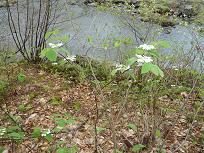
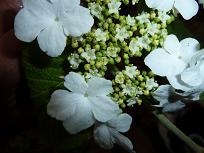 This is a Viburnum with edible berries. The berries are red at first and then
turn black when ripened. I will go back and collect some in the late Summer or Fall.
This is a Viburnum with edible berries. The berries are red at first and then
turn black when ripened. I will go back and collect some in the late Summer or Fall.
These are typical Viburnum flowers with big white 5-petal sterile flowers surrounding
a cluster of little white flowers in the center. The leaves of Viburnum are of
varying shapes, but this is the only Viburnum in New Hampshire that has very
big leaves without deep teeth on the margin. A Couple of useful Viburnum
resources:
Is it a Viburnum? and
Which Viburnum Is It?.
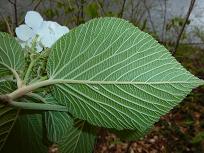

May 8, 2011
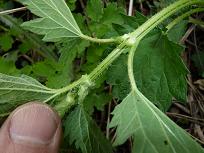
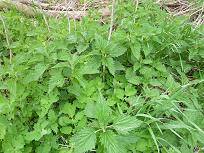 Dwarf Nettle has opposite leaves like Stinging Nettle (Urtica dioica), but
its leaves are bigger and have fewer and far deeper teeth. The plant only grows
up to 2 feet tall. It seems to have numerous stinging hairs on the stem and fewer
on the leaves. At this point in the year, the stingers are too flexible to penetrate
the skin.
Dwarf Nettle has opposite leaves like Stinging Nettle (Urtica dioica), but
its leaves are bigger and have fewer and far deeper teeth. The plant only grows
up to 2 feet tall. It seems to have numerous stinging hairs on the stem and fewer
on the leaves. At this point in the year, the stingers are too flexible to penetrate
the skin.
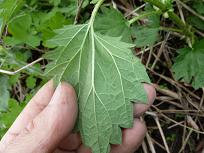
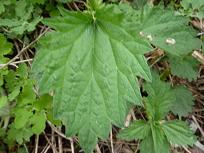 As far as I can tell, Dwarf Nettle is edible just like Stinging Nettle. (See:
“Edible and Useful Plants of Texas and the Southwest: A Practical Guide”
by Delena Tull and
Edible Plants of Florda.) Young leaves can be cooked and eaten. Older leaves
can be used to make a healthy tea to drink or to use for skin treatment (in a
shampoo for example).
As far as I can tell, Dwarf Nettle is edible just like Stinging Nettle. (See:
“Edible and Useful Plants of Texas and the Southwest: A Practical Guide”
by Delena Tull and
Edible Plants of Florda.) Young leaves can be cooked and eaten. Older leaves
can be used to make a healthy tea to drink or to use for skin treatment (in a
shampoo for example).
May 9, 2011
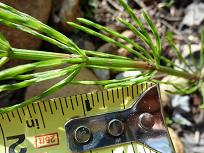

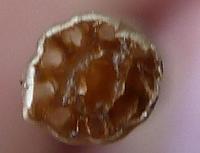
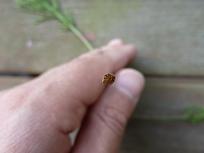
May 10, 2011
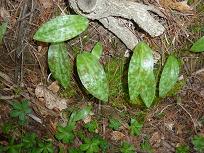 I tried raw Trout Lily. It is excellent. Somewhat of a cucumber-like taste. I like it
much better than cooked Trout Lily. Found a huge supply in the woods across the street
from my discovery of Trout Lily in April.
I tried raw Trout Lily. It is excellent. Somewhat of a cucumber-like taste. I like it
much better than cooked Trout Lily. Found a huge supply in the woods across the street
from my discovery of Trout Lily in April.
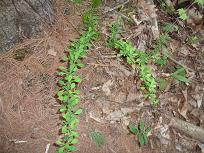
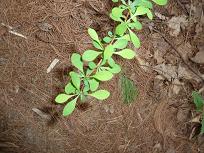 I have nibbled on young Japanese Barberry leaves a few times.
Wildman Steve Brill has a Wild Food
Application and has proven very useful. He says that the berries are unpleasant and
bitter which I comfirmed last year when I tried making Japanese Barberry jam. He goes
on to say that the young leaves have a pleasant sour taste. Well, I've been trying
them for the last couple of weeks using the youngest possible leaves and I agree that
there is initially a pleasant sour taste, but it is quickly followed by an unpleasant
bitter aftertaste. Maybe I will have to try in mid-April next year.
I have nibbled on young Japanese Barberry leaves a few times.
Wildman Steve Brill has a Wild Food
Application and has proven very useful. He says that the berries are unpleasant and
bitter which I comfirmed last year when I tried making Japanese Barberry jam. He goes
on to say that the young leaves have a pleasant sour taste. Well, I've been trying
them for the last couple of weeks using the youngest possible leaves and I agree that
there is initially a pleasant sour taste, but it is quickly followed by an unpleasant
bitter aftertaste. Maybe I will have to try in mid-April next year.
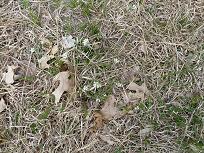
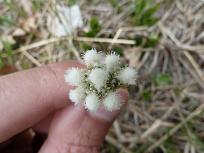
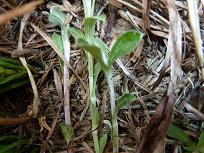
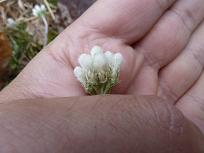
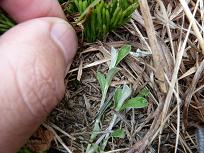
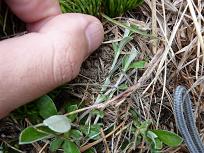
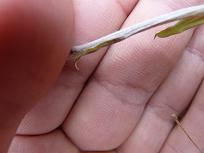
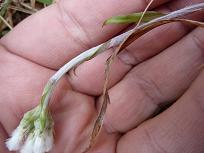
May 12, 2011
Arrowleaf Violet (Viola sagittata var. ovata)
(Synonym: Viola fimbriatula)
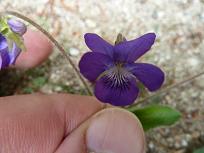
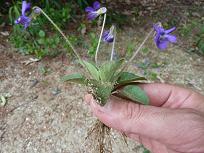
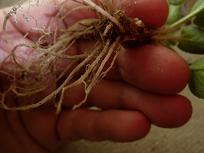
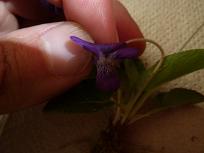
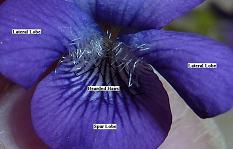
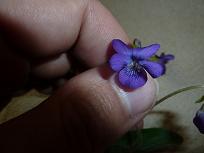
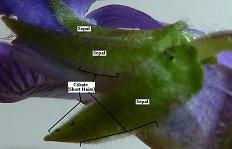


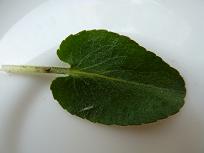
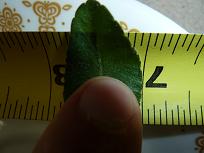
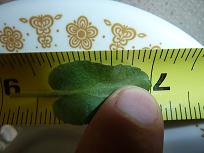
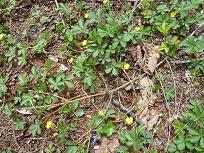
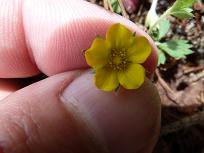 After looking for Canadian Dwarf Cinquefoil all of last year, I found a big patch
50 yards from my front door! Now I can finish differentiating between five of the most
common types of cinquefoil in my area on the
Cinquefoils
Identification page.
After looking for Canadian Dwarf Cinquefoil all of last year, I found a big patch
50 yards from my front door! Now I can finish differentiating between five of the most
common types of cinquefoil in my area on the
Cinquefoils
Identification page.
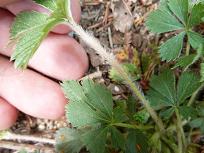
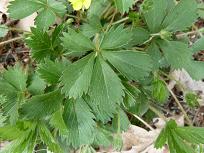 Differences between Canadian Dwarf Cinquefoil (Potentilla canadensis) and
Common Cinquefoil (Potentilla simplex):
Differences between Canadian Dwarf Cinquefoil (Potentilla canadensis) and
Common Cinquefoil (Potentilla simplex):
- Flower stem arises from the axil of the 2nd leaf for Common Cinquefoil and from the
leaf axil of the first leaf for Canadian Dwarf Cinquefoil.
(Audubon Society field Guide)
- Margin teeth do not go below the top 1/2 of the leaflet for Canadian Dwarf Cinquefoil
and are toothed for approximately 3/4 of their length for Common Cinquefoil.
(Newcomb’s,
Clemants & Gracie)
- Leaflets for Common Cinquefoil are elliptical to somewhat wedge-shaped (obovate)
while the leaflets for Canadian Dwarf Cinquefoil are very obovate, sharting out very thin
at the bottom and relatively very wide at the tip.
(Peterson)
- Hairs on flower stem (peduncle) and leaf stem (petiole) are dense and spreading for
Canadian Dwarf Cinquefoil and are appressed for Common Cinquefoil.
(Weeds of the Northeast,
Clemants & Gracie)
Apparently, Common Cinquefoil can vary anywhere from nearly hairless to appressed hairs.
- Leaflets for Canadian Dwarf Cinquefoil grow up to 1-1/2 inches (4 cm) long and for
Common Cinquefoil the leaflets grow up to 2-1/2 inches (6.5 cm) long.
(Audubon Society field guide)
- The stipules (appendages at the base of the leaf) of the basal leaves are
oblong-lanceolate and flat for Canadian Dwarf Cinquefoil and are linear-lanceolate
and rolled for Common Cinquefoil.
(Weeds of the Northeast)
- The rhizomes (underground stems) for Common Cinquefoil grow up to 3 inches (8 cm)
long while the rhizomes for Canadian Dwarf Cinquefoil only grow up to 3/4 inches (2 cm)
long.
(Weeds of the Northeast)
- Canadian Dwarf Cinquefoil bloom from April until June while Common Cinquefoil
blooms from May until July.
NH Wildflowers Color Thumbnails: Yellow
May 17, 2011
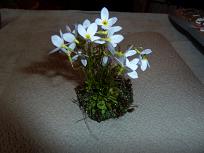
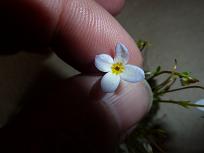
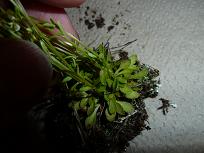
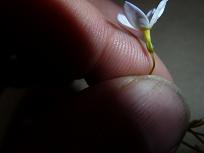
May 20, 2011
Starflower (Trientalis borealis)

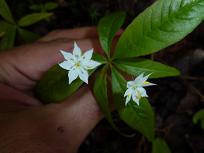
May 21, 2011
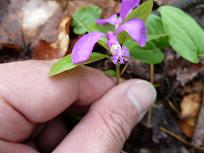
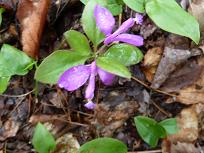 Very distinctive pair of purple flowers. I saw it last year, but after it was done
flowering, I could not recognize it. Notice that the leaves congregate near the top
as if they are whorled, but in the pictures (2nd row) you can see that they actually
alternate near the top of the stem. The leaves have no teeth (entire) and have a very
slight red tinge near the outer edge.
Very distinctive pair of purple flowers. I saw it last year, but after it was done
flowering, I could not recognize it. Notice that the leaves congregate near the top
as if they are whorled, but in the pictures (2nd row) you can see that they actually
alternate near the top of the stem. The leaves have no teeth (entire) and have a very
slight red tinge near the outer edge.
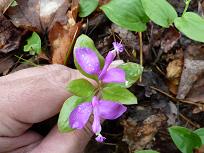
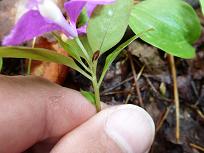
May 28, 2011
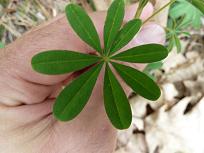
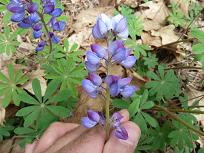 I used the
USDA Plant Database Advanced Search to list every plant in
New Hampshire that is a member of the Pea family (Fabaceae)
and then went through all of them to make sure I had this identification
correct. In addition, I used the Weed
Identification Software to begin the identification process.
I used the
USDA Plant Database Advanced Search to list every plant in
New Hampshire that is a member of the Pea family (Fabaceae)
and then went through all of them to make sure I had this identification
correct. In addition, I used the Weed
Identification Software to begin the identification process.
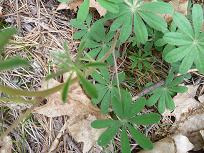
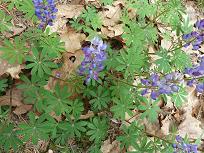 There is another species of Lupine found in the Northern part of New Hampshire
(Coos County) and in the Southwestern part of New Hampshire (Cheshire County).
It is called Big Leaf Lupine (Lupinus polyphyllus). It
has 11-17 palmately divided leaflets. The leaflets are much longer with a
pointed tip.
There is another species of Lupine found in the Northern part of New Hampshire
(Coos County) and in the Southwestern part of New Hampshire (Cheshire County).
It is called Big Leaf Lupine (Lupinus polyphyllus). It
has 11-17 palmately divided leaflets. The leaflets are much longer with a
pointed tip.
May 30, 2011
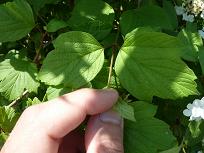
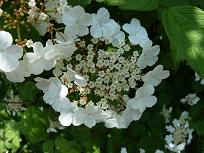 In New Hampshire, there are only a small number of Viburnums with lobed leaves:
In New Hampshire, there are only a small number of Viburnums with lobed leaves:
- American Cranberrybush (Viburnum opulus var. americanum)
- European Cranberrybush (Viburnum opulus var. opulus)
- Mapleleaf Viburnum (Viburnum acerifolium)
- Squashberry (Viburnum edule)
One of the most obvious differences is that Mapleleaf Viburnum and Squashberry
do not have the large, showy sterile flowers. They only have the smaller white flowers.
Also, Mapleleaf Viburnum does not have swollen glands on the leaf petioles. The
margins of Squashberry leaves have many teeth compared to the few teeth on the
leaf margins of Cranberrybush.
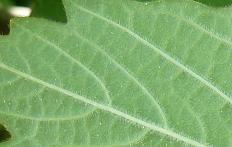
 The Peterson Field Guide for Edible Plants says, ‘A European
ornamental occasionally escaped from cultivation,
V. opulus [Viburnum opulus var. opulus], is
almost a double for Highbush-cranberry, but with bitter fruit.”
For this reason, it is important to tell the two apart.
The Peterson Field Guide for Edible Plants says, ‘A European
ornamental occasionally escaped from cultivation,
V. opulus [Viburnum opulus var. opulus], is
almost a double for Highbush-cranberry, but with bitter fruit.”
For this reason, it is important to tell the two apart.
The following web page shows how to tell the two apart (using
a table and two links for pictures):
http://oregonstate.edu/dept/ldplants/vitr.htm. The American
Cranberrybush has a wide and shallow groove on the leaf petiole,
small glands on the petiole and hairs only the leaf veins of the underside
of the leaf. The European Cranberrybush has a thin groove
on the leaf petiole, larger, disk-shaped glands on the petiole and
hairs on the underside of the leaf in addition to the leaf vein hairs.
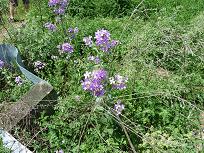
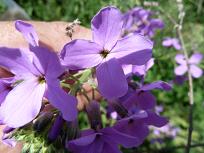 The leaves are edible (raw or cooked) when gathered in April or May before the flowering
stem appears. At this time, any slight bitterness can be reduced with cooking. Changes
to cooking water can reduce bitterness if the leaves are picked later in the Spring
after flowering. The rosette of leaves produced in the Fall tends to be mild and
can be collected into the very late Fall.
The leaves are edible (raw or cooked) when gathered in April or May before the flowering
stem appears. At this time, any slight bitterness can be reduced with cooking. Changes
to cooking water can reduce bitterness if the leaves are picked later in the Spring
after flowering. The rosette of leaves produced in the Fall tends to be mild and
can be collected into the very late Fall.
The picture I took were not very clear for showing the alternate leaf arrangement
and the hairs on the stem and leaves. I will go back over the next couple of
weeks and take more pictures which you will be able to find at:
http://www.transformationalgardening.com/forage/plants/hesperis-matronalis-images.html.
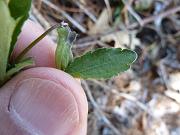
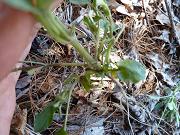
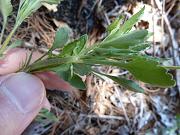
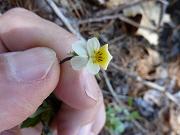
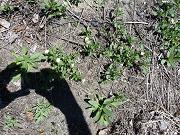

 My first violet posted to this site! Notice how the flowers are bilaterally symetrical.
That means that if you drew a line down the center, the left and right sides would
be the same. This is similar to the human body (the left and right sides are the same).
My first violet posted to this site! Notice how the flowers are bilaterally symetrical.
That means that if you drew a line down the center, the left and right sides would
be the same. This is similar to the human body (the left and right sides are the same).
 The basal leaves are round to spatulate. The middle and upper leaves tend to be
elliptical with coarsely-rounded teeth. The leaf veins on the underside of the leaf
are hairy.
The basal leaves are round to spatulate. The middle and upper leaves tend to be
elliptical with coarsely-rounded teeth. The leaf veins on the underside of the leaf
are hairy.








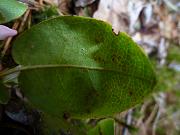
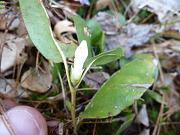
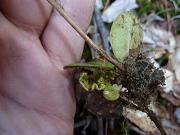
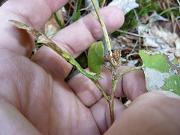

 I had thought this was Ostrich Fern (Matteuccia struthiopteris) as
almost every foraging guide says to look for a deep groove, brown papery
sheath falling off the fiddlehead and no hairs. Thank you to Frank and to Arthur
for pointing out that this is Intermediate Woodfern. Arthur told me:
I had thought this was Ostrich Fern (Matteuccia struthiopteris) as
almost every foraging guide says to look for a deep groove, brown papery
sheath falling off the fiddlehead and no hairs. Thank you to Frank and to Arthur
for pointing out that this is Intermediate Woodfern. Arthur told me: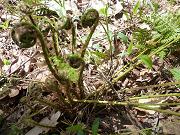
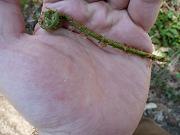
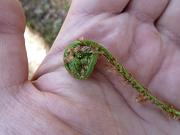
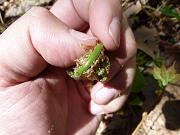

 For me, differentiating between species of violet can be very easy in some cases and
very difficult in other cases. If I had to rely on descriptions in a typical field
guide, I would have no chance, especially in this case. What I think is far better
are step-by-step “Identification Keys”. The one I found the most useful
for Violets in my area is the
New Brunswick Botany Club Violet Indentification Key (also found
in PDF format here).
A couple of other useful keys were the
Northern Ontario Plant Database Violet Key (scroll down to see Key) and the
American Violet Society Dichotomous Key (Eastern U.S.).
For me, differentiating between species of violet can be very easy in some cases and
very difficult in other cases. If I had to rely on descriptions in a typical field
guide, I would have no chance, especially in this case. What I think is far better
are step-by-step “Identification Keys”. The one I found the most useful
for Violets in my area is the
New Brunswick Botany Club Violet Indentification Key (also found
in PDF format here).
A couple of other useful keys were the
Northern Ontario Plant Database Violet Key (scroll down to see Key) and the
American Violet Society Dichotomous Key (Eastern U.S.).
 The second row of pictures show that the plant has no above-ground stem -- leaf stems
and flower stems come right from the level of the ground. This eliminated Viola adunca
and Viola labradorica as possibilities. The second picture in the row shows there
are hairs on the lateral (side) petals of the flower. This eliminated Viola selkirkii
as a possibility. In addition, you can see that the little hairs are not dialated
(swollen) at the apex (tip). This eliminated Viola cucullata and Viola
x bissellii as possibilities.
The second row of pictures show that the plant has no above-ground stem -- leaf stems
and flower stems come right from the level of the ground. This eliminated Viola adunca
and Viola labradorica as possibilities. The second picture in the row shows there
are hairs on the lateral (side) petals of the flower. This eliminated Viola selkirkii
as a possibility. In addition, you can see that the little hairs are not dialated
(swollen) at the apex (tip). This eliminated Viola cucullata and Viola
x bissellii as possibilities.
 The third row of pictures show that the sepals (the petals that lie under the flower
and are usually green) are ciliate (have short hairs). There are other ways to
differentiate between violets, but I think this is the most efficient process.
This eliminated Viola novae-angliae and Viola nephrophylla as
possibilities.
The third row of pictures show that the sepals (the petals that lie under the flower
and are usually green) are ciliate (have short hairs). There are other ways to
differentiate between violets, but I think this is the most efficient process.
This eliminated Viola novae-angliae and Viola nephrophylla as
possibilities.
 The fourth row of pictures shows that the typical leaf is as long or longer than it
is wide. Therefore, I was able to eliminate Viola sagittata var. ovata as a
possibility. According to this Key, the only option left was Viola sororia.
The fourth row of pictures shows that the typical leaf is as long or longer than it
is wide. Therefore, I was able to eliminate Viola sagittata var. ovata as a
possibility. According to this Key, the only option left was Viola sororia.
 This left either the original Key selection, Viola sororia or
Viola septentrionalis. Several descriptions I ready for Viola
sororia said that the spur flower petal (bottom middle petal) had no
hairs. But as can be seen from the pictures on the fifth row, the bottom
middle flower petal (spur petal) has hairs. Even though Viola septentrionalis
is often categorized under Viola sororia, it has a spur petal with hairs.
This left either the original Key selection, Viola sororia or
Viola septentrionalis. Several descriptions I ready for Viola
sororia said that the spur flower petal (bottom middle petal) had no
hairs. But as can be seen from the pictures on the fifth row, the bottom
middle flower petal (spur petal) has hairs. Even though Viola septentrionalis
is often categorized under Viola sororia, it has a spur petal with hairs.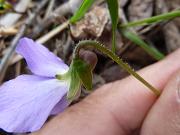
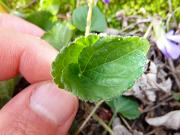
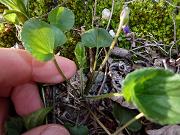
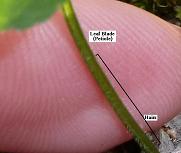
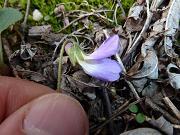
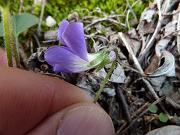
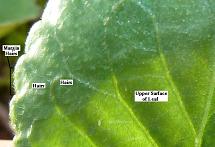




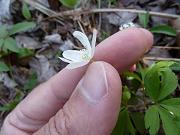
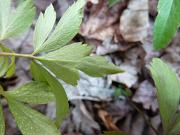
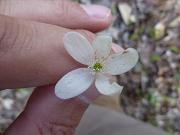
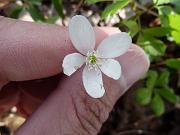




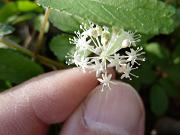
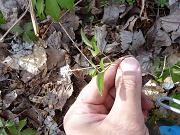
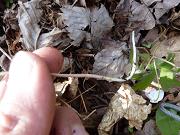
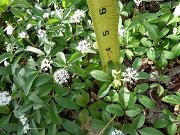

 This is a Viburnum with edible berries. The berries are red at first and then
turn black when ripened. I will go back and collect some in the late Summer or Fall.
This is a Viburnum with edible berries. The berries are red at first and then
turn black when ripened. I will go back and collect some in the late Summer or Fall.

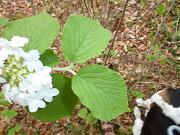

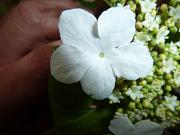
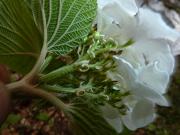

 Dwarf Nettle has opposite leaves like Stinging Nettle (Urtica dioica), but
its leaves are bigger and have fewer and far deeper teeth. The plant only grows
up to 2 feet tall. It seems to have numerous stinging hairs on the stem and fewer
on the leaves. At this point in the year, the stingers are too flexible to penetrate
the skin.
Dwarf Nettle has opposite leaves like Stinging Nettle (Urtica dioica), but
its leaves are bigger and have fewer and far deeper teeth. The plant only grows
up to 2 feet tall. It seems to have numerous stinging hairs on the stem and fewer
on the leaves. At this point in the year, the stingers are too flexible to penetrate
the skin.
 As far as I can tell, Dwarf Nettle is edible just like Stinging Nettle. (See:
“Edible and Useful Plants of Texas and the Southwest: A Practical Guide”
by Delena Tull and
Edible Plants of Florda.) Young leaves can be cooked and eaten. Older leaves
can be used to make a healthy tea to drink or to use for skin treatment (in a
shampoo for example).
As far as I can tell, Dwarf Nettle is edible just like Stinging Nettle. (See:
“Edible and Useful Plants of Texas and the Southwest: A Practical Guide”
by Delena Tull and
Edible Plants of Florda.) Young leaves can be cooked and eaten. Older leaves
can be used to make a healthy tea to drink or to use for skin treatment (in a
shampoo for example).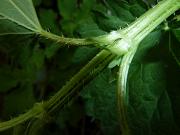
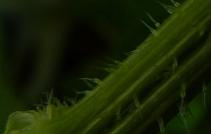
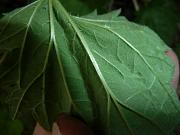





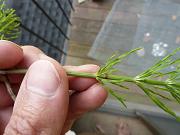
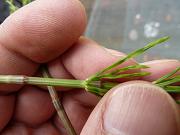
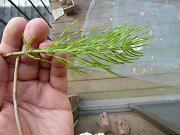
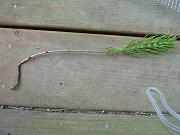
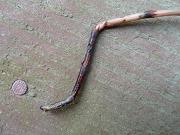
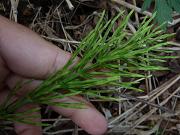
 I tried raw Trout Lily. It is excellent. Somewhat of a cucumber-like taste. I like it
much better than cooked Trout Lily. Found a huge supply in the woods across the street
from my discovery of Trout Lily in April.
I tried raw Trout Lily. It is excellent. Somewhat of a cucumber-like taste. I like it
much better than cooked Trout Lily. Found a huge supply in the woods across the street
from my discovery of Trout Lily in April.
 I have nibbled on young Japanese Barberry leaves a few times.
Wildman Steve Brill has a Wild Food
Application and has proven very useful. He says that the berries are unpleasant and
bitter which I comfirmed last year when I tried making Japanese Barberry jam. He goes
on to say that the young leaves have a pleasant sour taste. Well, I've been trying
them for the last couple of weeks using the youngest possible leaves and I agree that
there is initially a pleasant sour taste, but it is quickly followed by an unpleasant
bitter aftertaste. Maybe I will have to try in mid-April next year.
I have nibbled on young Japanese Barberry leaves a few times.
Wildman Steve Brill has a Wild Food
Application and has proven very useful. He says that the berries are unpleasant and
bitter which I comfirmed last year when I tried making Japanese Barberry jam. He goes
on to say that the young leaves have a pleasant sour taste. Well, I've been trying
them for the last couple of weeks using the youngest possible leaves and I agree that
there is initially a pleasant sour taste, but it is quickly followed by an unpleasant
bitter aftertaste. Maybe I will have to try in mid-April next year.







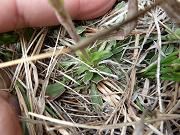
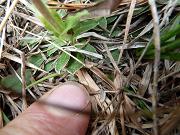
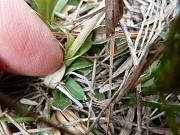
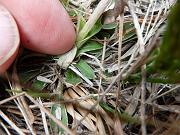
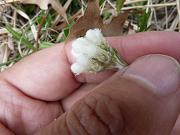
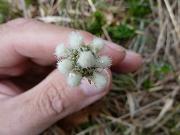












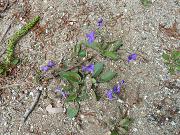
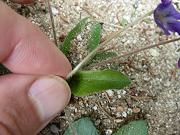
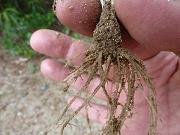

 After looking for Canadian Dwarf Cinquefoil all of last year, I found a big patch
50 yards from my front door! Now I can finish differentiating between five of the most
common types of cinquefoil in my area on the
Cinquefoils
Identification page.
After looking for Canadian Dwarf Cinquefoil all of last year, I found a big patch
50 yards from my front door! Now I can finish differentiating between five of the most
common types of cinquefoil in my area on the
Cinquefoils
Identification page.
 Differences between Canadian Dwarf Cinquefoil (Potentilla canadensis) and
Common Cinquefoil (Potentilla simplex):
Differences between Canadian Dwarf Cinquefoil (Potentilla canadensis) and
Common Cinquefoil (Potentilla simplex):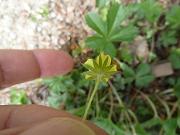
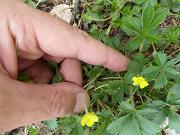
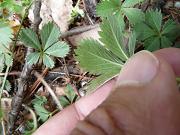
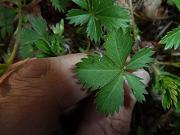
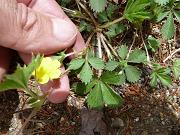
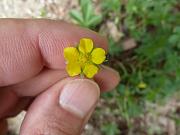
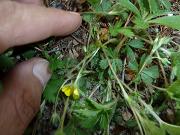




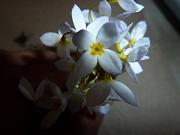
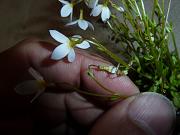
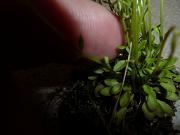
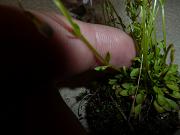
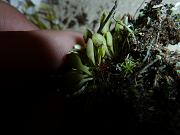
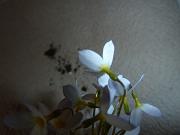


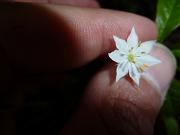
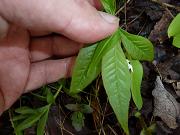
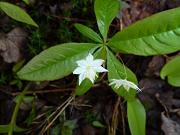
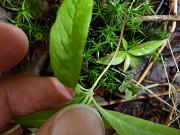

 Very distinctive pair of purple flowers. I saw it last year, but after it was done
flowering, I could not recognize it. Notice that the leaves congregate near the top
as if they are whorled, but in the pictures (2nd row) you can see that they actually
alternate near the top of the stem. The leaves have no teeth (entire) and have a very
slight red tinge near the outer edge.
Very distinctive pair of purple flowers. I saw it last year, but after it was done
flowering, I could not recognize it. Notice that the leaves congregate near the top
as if they are whorled, but in the pictures (2nd row) you can see that they actually
alternate near the top of the stem. The leaves have no teeth (entire) and have a very
slight red tinge near the outer edge.


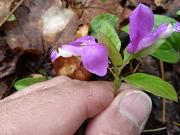
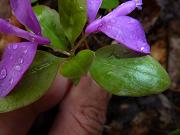
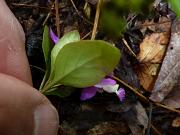


 I used the
USDA Plant Database Advanced Search to list every plant in
New Hampshire that is a member of the Pea family (Fabaceae)
and then went through all of them to make sure I had this identification
correct. In addition, I used the Weed
Identification Software to begin the identification process.
I used the
USDA Plant Database Advanced Search to list every plant in
New Hampshire that is a member of the Pea family (Fabaceae)
and then went through all of them to make sure I had this identification
correct. In addition, I used the Weed
Identification Software to begin the identification process.
 There is another species of Lupine found in the Northern part of New Hampshire
(Coos County) and in the Southwestern part of New Hampshire (Cheshire County).
It is called Big Leaf Lupine (Lupinus polyphyllus). It
has 11-17 palmately divided leaflets. The leaflets are much longer with a
pointed tip.
There is another species of Lupine found in the Northern part of New Hampshire
(Coos County) and in the Southwestern part of New Hampshire (Cheshire County).
It is called Big Leaf Lupine (Lupinus polyphyllus). It
has 11-17 palmately divided leaflets. The leaflets are much longer with a
pointed tip.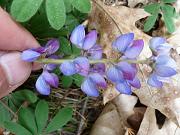
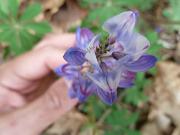
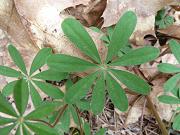
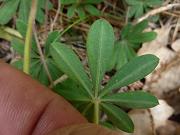

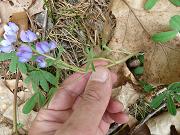
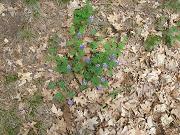
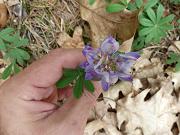

 In New Hampshire, there are only a small number of Viburnums with lobed leaves:
In New Hampshire, there are only a small number of Viburnums with lobed leaves:
 The Peterson Field Guide for Edible Plants says, ‘A European
ornamental occasionally escaped from cultivation,
V. opulus [Viburnum opulus var. opulus], is
almost a double for Highbush-cranberry, but with bitter fruit.”
For this reason, it is important to tell the two apart.
The Peterson Field Guide for Edible Plants says, ‘A European
ornamental occasionally escaped from cultivation,
V. opulus [Viburnum opulus var. opulus], is
almost a double for Highbush-cranberry, but with bitter fruit.”
For this reason, it is important to tell the two apart.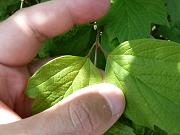
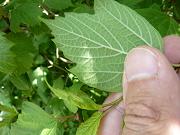

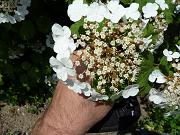
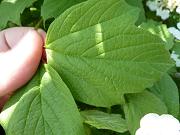
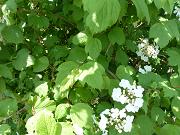

 The leaves are edible (raw or cooked) when gathered in April or May before the flowering
stem appears. At this time, any slight bitterness can be reduced with cooking. Changes
to cooking water can reduce bitterness if the leaves are picked later in the Spring
after flowering. The rosette of leaves produced in the Fall tends to be mild and
can be collected into the very late Fall.
The leaves are edible (raw or cooked) when gathered in April or May before the flowering
stem appears. At this time, any slight bitterness can be reduced with cooking. Changes
to cooking water can reduce bitterness if the leaves are picked later in the Spring
after flowering. The rosette of leaves produced in the Fall tends to be mild and
can be collected into the very late Fall.